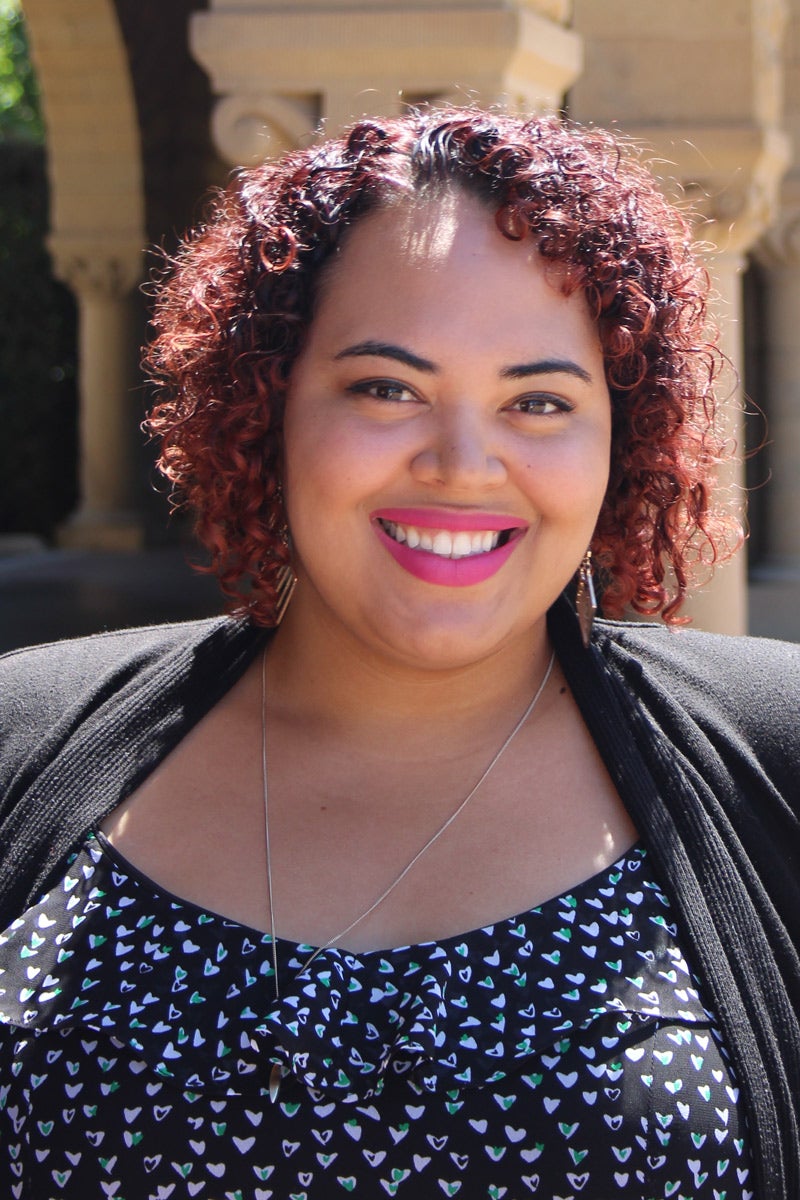Stanford graduate student finds patterns in stories about multiracialism
English doctoral student Vanessa Seals studies contemporary American novels and memoirs about multiracial people’s experiences to examine the role families play in their search for identity.

Vanessa Seals (Image credit: Margaret Sena)
Who am I? It’s a question many of us ask at some point in our lives.
Vanessa Seals, a doctoral student in English, is exploring how people of mixed race tackle this question and form their racial identities.
Seals read and analyzed more than 50 contemporary American novels and memoirs, largely written in the past two decades, about the experiences of multiracial people as part of her dissertation research. She found that mixed-race individuals represented in the literature almost always look to their family and relatives when trying to figure out who they are.
Most of the early multiracial advocates have largely considered the process of racial identity as a personal journey. Seals argues that racial identification is more complicated.
“This idea that ‘it’s up to me to determine who I am’ isn’t really completely accurate,” Seals said. “It’s a very individualistic narrative and it evacuates identity of any context.”
Some public discourse has uncritically celebrated mixed-race identity as an expression of unfettered free will, with some even describing the “mixed-race generation” as the answer to racial issues in America, according to Michele Elam, professor of English and Seals’ adviser.
“Mixed-race people are not a new demographic that will save the world,” Elam said. “Vanessa’s work is going beyond those simple celebratory narratives and tries to explore how novels imagine the family dynamics that often form personal racial identities.”
Decriminalizing racial mixing
The topic of race mixing in the U.S. was a taboo subject for generations. The legalization of interracial marriage in 1967 following the U.S. Supreme Court’s ruling in Loving v. Virginia finally normalized multiracialism, Seals and Elam said.
But progress has been slow. It wasn’t until 2000 that multiracial Americans could identify with more than one race on the U.S. Census.
“There wasn’t a language available for interracial families before then,” Seals said. “The words ‘multiracial’ and ‘mixed race’ weren’t really in use to describe a separate identity before the 1990s.”
That’s why Seals’ research focuses on works published post-1990, coinciding with a surge in literary works from mixed-race authors.
Seals said mixed-racial identity has been discussed in American books from previous periods, but the new vocabulary and conception of multiracialism has led to a new kind of writing about mixed race.
Seals, who came to Stanford in 2010 to pursue her master’s and doctoral degrees, said the idea for her dissertation emerged gradually after she began engaging with scholars in critical mixed-race studies – a relatively new field based on the premise that race is a complex societal issue that affects the way people experience the world.
Seals said her research is personal because she is mixed-race (Seals’ mother is white and her father is black). Seals grew up Mormon in a small town in Utah with her mother’s family. She loved reading novels from a young age, but was not exposed to many diverse authors or narratives until attending the University of Utah, where she earned her bachelor’s degree in English.
“My research ended up being ‘me research’ in a way,” Seals said.
Patterns in mixed-race stories
A common theme Seals found within the narratives is a sense of being stuck in between two worlds – and the main character’s central question of “Who am I?” routinely posed to his or her parents.
“The negotiation of racial identify is never just the child’s burden,” Seals said. “It’s a question that the family together attempts to figure out.”
Characters also use objects and records to reconstruct and understand their identities, Seals said. For example, in the 2006 memoir The Skin Between Us: A Memoir of Race, Beauty and Belonging, author Kym Ragusa describes relying on archives to answer questions about her existence to bridge the gap created by the hatred existing between her father’s Italian American relatives and her mother’s African American family.
A part of Seals’ research also focuses on the strong bond portrayed between multiracial siblings. Authors describe a deep understanding and connection between mixed-race siblings, who are depicted as lonely inhabitants of a world unique only to them, Seals said.
The relationships between those siblings follow a predictable tension arc: They grow up to find out that they are different despite their deep, personal connection. In the 2007 book Hapa Girl: A Memoir, author May-lee Chai, who was born to a Chinese American father and a white mother, shares how she and her brother, Jeff, created a space between their closets where they could talk freely about the prejudice they experienced at school. Their parents denied the existence of racism in their town.
Examining social issues through literature
Early work in race scholarship primarily derived from the perspectives of history, psychology and sociology. Fewer scholars have explored race through the lens of the arts and literature, Elam said. As her own scholarship argues, however, the arts, however, present an important platform through which the intricacies of race and mixed race can be explored.
“Literature doesn’t necessarily prescribe public policy, but it can both reflect and shape changing public sentiments,” Elam said.
That’s in part what also makes Seals’ project unique, Elam said.
“Art forms such as literature reflect our culture,” Seals said. “It’s useful to look at how people filter their reality and current events on an artistic level.”
